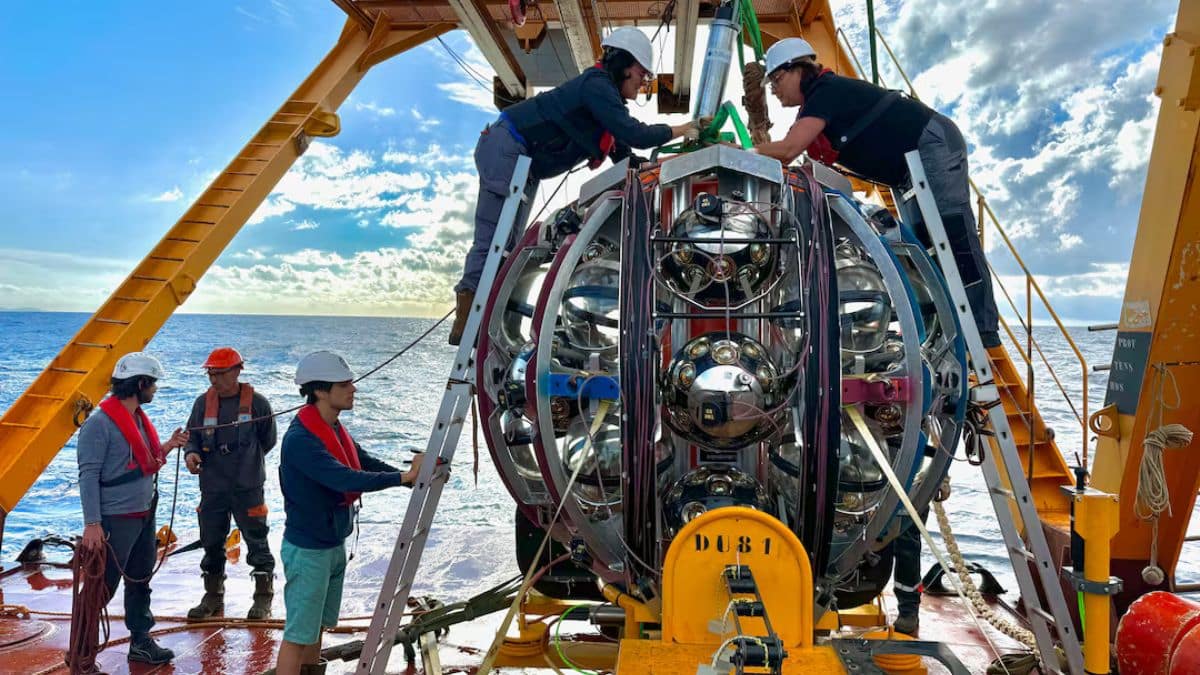Scientists have made a groundbreaking discovery in the depths of the Mediterranean Sea that may revolutionize our understanding of cosmic phenomena. In February 2023, researchers detected a neutrino with unprecedented energy levels, opening new pathways for exploring the universe’s most distant regions and energetic events.
Extraordinary particle detection beneath Mediterranean waters
At a depth of 2,450 meters below the Mediterranean surface, the KM3NeT telescope captured something truly remarkable – a neutrino with an energy level of 120 PeV. This subatomic particle carries 20 times more energy than any previously recorded neutrino, representing a significant milestone in astrophysical research.
The KM3NeT telescope, anchored to the seabed off Sicily’s coast, was designed specifically to detect these elusive particles that typically pass through matter without leaving traces. Despite operating at only 10% of its planned capacity during this discovery, the telescope’s sensitive equipment successfully identified this extraordinary cosmic messenger.
What makes this discovery particularly significant is that the particle appears to have originated from the edge of the observable universe. As noted by Elisa Resconi from the IceCube observatory, this “colossal” event marks a turning point in how scientists can track extremely high-energy cosmic phenomena.
In 2019, Iceland Approved the 4-Day Workweek: Nearly 6 Years Later, All Forecasts by Generation Z Have Come True
At 94, He’s One of Apple’s Biggest Shareholders, and Doctors Can’t Explain How He’s Still Alive-Coca-Cola and McDonald’s Are Part of His Daily Routine
KM3NeT: harvesting cosmic secrets from ocean depths
The KM3NeT telescope represents a marvel of modern scientific engineering. This underwater observatory consists of thousands of specialized sensors strategically positioned to capture the faint signals produced when neutrinos interact with surrounding matter.
The telescope’s design includes:
- Digital optical modules (DOMs) equipped with 31 light-sensitive photomultiplier tubes
- Titanium components designed to withstand extreme deep-sea conditions
- Vertical acquisition units connected by specialized cables
- Detection systems optimized for capturing neutrino interactions
During the landmark detection, the high-energy neutrino produced a secondary particle called a muon as it passed through Earth. This muon trajectory pointed toward Greece, helping scientists determine that the neutrino originated from a distant galaxy far beyond our Milky Way.
Since this remarkable observation, the research team has added 12 more detector chains to enhance the telescope’s capabilities, significantly improving its ability to capture and analyze these rare cosmic visitors.
It races through the universe at 300,000 km/s - and never runs out of energy
Beneath your feet: an ancient forgotten continent resurfaces in Europe
Cosmic origins and astrophysical implications
The precise source of ultra-high-energy neutrinos remains one of astronomy’s most compelling mysteries. These particles likely emerge from extreme cosmic environments where extraordinary amounts of energy are released.
| Potential Neutrino Sources | Energy Range | Detection Probability |
|---|---|---|
| Supermassive black holes | 100+ PeV | Very rare |
| Supernova explosions | 1-10 PeV | Rare |
| Gamma-ray bursts | 10-100 PeV | Extremely rare |
What makes neutrinos particularly valuable for cosmic research is their ability to travel across vast distances without being deflected by magnetic fields or absorbed by matter. Unlike light or other forms of radiation, these ghostly particles maintain their original trajectory from source to detection point.
The 120 PeV neutrino detected by KM3NeT provides scientists with unprecedented data about cosmic accelerators capable of producing particles with such extreme energy levels. These accelerators likely represent some of the most powerful phenomena in the universe, potentially including active galactic nuclei, where supermassive black holes consume surrounding matter at extraordinary rates.
As KM3NeT continues its construction toward full operational capacity, astronomers anticipate detecting more of these rare high-energy particles. Each detection will help map the universe’s most energetic regions and potentially identify previously unknown cosmic structures responsible for accelerating particles to such extreme energies.







